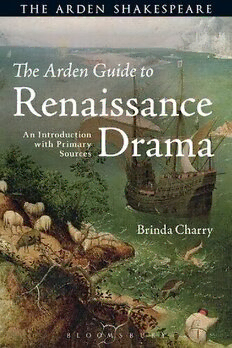Table Of ContentThe Arden
Guide to
Renaissance
Drama
An Introduction with
Primary Sources
Brinda Charry
Bloomsbury Arden Shakespeare
An imprint of Bloomsbury Publishing Pic
ß L O O M S B U R Y
LONDON • OXFORD • NEW YORK • NEW DELHI • SYDNEY
Bloomsbury Arden Shakespeare
An imprint of Bloomsbury Publishing Pic
Imprint previously known as Arden Shakespeare
50 Bedford Square 1385 Broadway
London New York
WC1B3DP NY 10018
UK USA
www.bloomsbury.com
BLOOMSBURY,THE ARDEN SHAKESPEARE and the Diana logo are trademarks of
Bloomsbury Publishing Pic
First published 2017
© Brinda Charry, 2017
Brinda Charry has asserted her right under the Copyright, Designs and Patents Act,
1988, to be identified as author of this work.
All rights reserved. No part of this publication may be reproduced or transmitted
in any form or by any means, electronic or mechanical, including photocopying,
recording, or any information storage or retrieval system, without prior
permission in writing from the publishers.
No responsibility for loss caused to any individual or organization acting on
or refraining from action as a result of the material in this publication can be
accepted by Bloomsbury or the author.
British Library Cataloguing-in-Publication Data
A catalogue record for this book is available from the British Library.
ISBN: HB: 978-1-472-57225-7
PB: 978-1-472-57224-0
ePDF: 978-1^72-57227-1
eBook: 978-1-472-57226-4
Library of Congress Cataloging-in-Publication Data
Names: Charry, Brinda, author.
Title: The Arden guide to Renaissance drama : an introduction with
primary sources / Brinda Charry.
Description: London ; New York : Bloomsbury Arden Shakespeare:
Bloomsbury Arden Shakespeare, 2017.
Identifiers: LCCN 2017003695 | ISBN 9781472572240 (paperback) |
ISBN 9781472572257 (hardback) | ISBN 9781472572271 (ePDF) |
ISBN 9781472572264 (ePub)
Subjects: LCSH: English drama—Early modem and Elizabethan, 1500-1600—Study
and teaching (Higher) | English drama—17th century—Study and teaching (Higher). |
Renaissance—England—Study and teaching (Higher) | BISAC: LITERARY CRITICISM /
Drama. | LITERARY CRITICISM / Renaissance.
Classification: LCC PR653 .C46 2017 | DDC 822/.309-dc20 LC record
available at https://lccn.loc.gov/2017003695
Cover design: Dani Leigh
Cover image © Landscape with the Fall of Icarus, c.1555 (oil on canvas), Bruegel, Pieter
the Elder (c. 1525-69) /Musees Royaux des Beaux-Arts de Belgique, Brussels, Belgium /
Bridgeman Images
Typeset by RefineCatch Limited, Bungay, Suffolk
Printed and bound in Great Britain
To find out more about our authors and books visit www.bloomsbury.com. Here you will
find extracts, author interviews, details of forthcoming events and the option to sign up
for our newsletters.
IV
For my teachers
v
vi
Contents
List of Illustrations xi
List of Extracts xii
Preface xiv
Acknowledgements xvi
Part I
1 Politics and Society 3
Kingship 4
The English Reformation 9
Puritans 17
The Reformation and drama 18
The nation 23
Social rank 28
Discussion points 35
2 Men and Women
37
Sex, sexuality, marriage 38
Disorder 46
Manhood 49
Staging gender 50
Rulers, readers, writers 59
Discussion points 62
3 Travel and Trade
65
Old worlds 66
New worlds 78
Race and racism 84
Gendering difference 87
vii
viii Contents
Transforming identities 90
The marketplace of the world 91
Early colonialism 92
Discussion points 93
4 Humanism
95
‘The courts of ancient men: The study of the classics 97
Vernacular humanism 101
Humanism and English education 102
Courtly humanism 106
A humanist philosophy 108
Humanism and English drama 112
Discussion points 118
5 The Stage
121
The playhouses 122
Costumes and props 126
The players and their audience 129
Anti-theatrical writing 136
The stage as political space 144
Discussion points 146
Authors, Books and Readers 147
6
Authors 148
Books 151
From plays to literary works 155
Readers 162
Discussion points 164
7 Genre ies
Comedy 167
Tragedy 171
Mixed modes and histories 179
Discussion points 184
Contents ix
Language and Style i
8 87
English, the Vulgar tongue 187
Eloquence 189
Patterned speech 194
Varieties of speech 203
Discussion points 208
Part II
9 The Alchemist
h i
10 Arden of Faversham 217
11 Doctor Faust us
223
12 The Duchess of Maifi 229
13 Hamlet
235
14 Henry V 241
15 The Jew of Malta 247
16 The Knight of the Burning Pestle
253
17 The Roaring Girl
259
18 The Shoemaker's Holiday
265
19 The Spanish Tragedy 271
20 The Tempest
277
21 The Tragedy of Mariam 233
22 Volpone 289
Contents
Appendix 295
Suggested Reading 297
Notes 301
Index 331
List of Illustrations
1.1 ‘An Act for the Uniformity of Common Prayer, from the
Book of Common Prayer, 1559, Benton 1.95. 14
1.2 Frontispiece to the King James Bible, 1611, which shows the
Twelve Apostles at the top. Moses and Aaron flank the central
text. In the four corners sit Matthew, Mark, Luke and John,
authors of the four gospels, with their symbolic animals. At the
top, over the Holy Spirit in the form of a dove, is the
Tetragrammaton ‘mrr’ (‘YHWH’). 20
1.3 ‘General Description of England and Ireland’ by Laurence
Nowell, c. 1564. 27
2.1 Title page from Hie Mulier, or, The Man- Woman: Being a
Medicine to cure the Coltish Disease of the Staggers in the
Masculine-Feminines of our Times: Exprest in a briefe
Declamation, 1620. 57
2.2 The Plimpton ‘Sieve’ portrait of Queen Elizabeth I,
George Gower, 1579. 60
3.1 Map of Raleigh’s Colony in Virginia, 1585. 79
3.2 Discovery of America: Vespucci Landing in America. Jan van
der Straet, called Stradanus, c. 1587-89. 89
4.1 Title page from The Scholemaster, Roger Ascham, 1570. 104
5.1 Long View of London from Bankside, a panorama of London
by Wenceslaus Hollar, 1647. 122
6.1 ‘To the Reader’. Title page from Mr. William Shakespeares
comedies, histories, & tragedies: published according to the true
originall copies, 1623. 161
6.2 Title page from The workes of Beniamin Ionson, 1616. 161
xi

